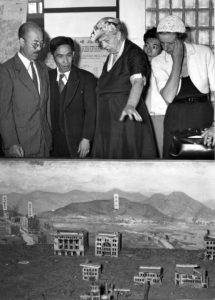Striving to fill voids in Hiroshima, unfinished judgment, Part 6: Reaction from nation that dropped atomic bombs
Apr. 28, 2024
Tepid support from American human rights groups
On June 16, 1953, at the conference venue for an informal meeting in the Tokyo metropolitan area, Shoichi Okamoto, an attorney who was in attendance from Osaka, waited for an opportunity to ask questions with memo in hand. The person he awaited was the guest of honor, Eleanor Roosevelt, a prominent American figure who, despite dying in 1962, is still known today as an advocate for human rights.
Her husband, former U.S. President Franklin Delano Roosevelt, who died in 1945, was the person that directed the development of the atomic bomb. Meanwhile, Ms. Roosevelt worked to have the United Nations adopt the Universal Declaration of Human Rights in 1948, when she was serving as U.S. representative to the United Nations. Mr. Okamoto believed that the declaration, which advocates for the respect of human rights, would serve as the basis for A-bomb survivors seeking compensation from the United States.
When Ms. Roosevelt visited Japan as part of a Japan–U.S. exchange program in May 1953, she made it to Hiroshima in early June. She met with a woman who suffered facial scars from the atomic bombing and children who had lost their parents.
The informal meeting was sponsored by the Japan Civil Liberties Union, which has as its aim the protection of human rights, among other organizations. Mr. Okamoto was a member of the civil liberties union.
Mr. Okamoto posed his questions to Ms. Roosevelt, asking, for example, “When you saw Hiroshima, did you consider that the atomic bombing was a violation of human rights?” and, “What are your opinions on the question of liability for damages caused by the atomic bombing?” According to the union’s official publication and other materials, Ms. Roosevelt mentioned how sorry she felt for the survivors.
Strong support for atomic bombs
Ms. Roosevelt continued on with an explanation about how the use of atomic bombs had not yet been addressed as an issue at an international tribunal. She pointed out that during the war, Japan had also been engaged in research on the development of an atomic bomb. Her comments could be construed as implying that the United States had no responsibility for use of the bombs.
In her earlier visit to Hiroshima City, she had described her thinking that America’s desire to bring the war to a conclusion as soon as possible and end all of the devastation from that conflict had led to use of the atomic bombs. She viewed the dropping of the bombs from the standpoint of strong support for the weapons, a stance that persists even today in the United States.
After that interaction, Mr. Okamoto continued to write letters to Americans who had an interest in the protection of human rights and request their cooperation in a lawsuit. However, barriers to support were high.
In early 1954, he sent a letter to Roger Baldwin, chair of the International League for Human Rights, through a collaborator. Mr. Baldwin had opposed the internment of Japanese-Americans living in the United States during World War II. Nevertheless, he refused to cooperate in the lawsuit, claiming that there were no legal grounds to do so and that it would harm Japan–U.S. relations.
Expensive legal fees
Mr. Okamoto also requested help from the attorney A. L. Wirin, who had handled numerous court cases involving Japanese-Americans. In May 1954, Mr. Okamoto received a positive reply from Mr. Wirin indicating that he had an interest in pursuing the matter. Later, Mr. Okamoto received a letter notifying him that the necessary legal fees would amount to at least 25,000 dollars (9.0 million yen at the time). In those days, the starting salary for government workers who were high school graduates was around 6,000 yen. The legal fees thus proved to be prohibitively expensive.
Mr. Okamoto had held up the ideal that Japanese lawyers should provide “free service” for the lawsuit while American attorneys should participate “out of a sense of justice.” He apparently could not conceal his shock at the response from the United States. Nevertheless, together with lawyers in Hiroshima, he explored other options.
Keywords
Universal Declaration of Human Rights
The Universal Declaration of Human Rights was adopted at the General Assembly of the United Nations in 1948, as a “common standard of achievement for all peoples and all nations” with respect to human rights. The declaration consists of a preamble and 30 articles. The preamble states that recognition of the dignity and equality of all human beings is the foundation of freedom, justice, and peace in the world, while the articles stipulate the right to life and security of all people, the right to freedom of expression, and the right to social guarantees, and more.
(Originally published on April 28, 2024)








